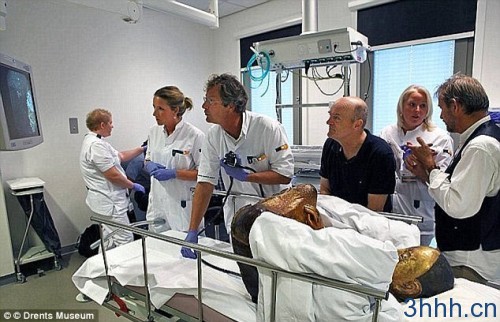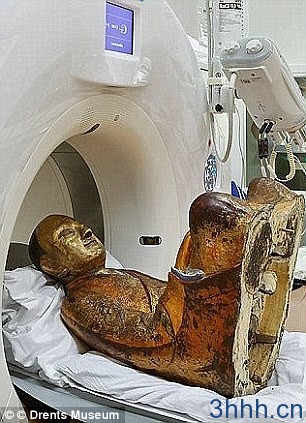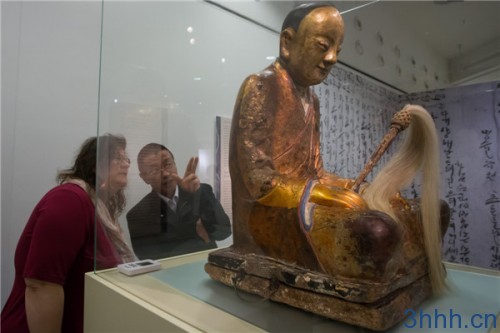|
论坛版主

|
阅读:2613回复:7
无障碍·translate·翻訳·二维码.cn/i3h.cn/393
|
|
论坛版主

|
沙发#
发布于:2015-11-26 13:59
After going through private channels with the collector to negotiate the
Buddha's return, nothing had been resolved, so representatives from the village signed an agreement with seven lawyers to bring the case to Dutch court. It is thought that the Dutch collector first responded by agreeing to return the statue if it was proven to have belonged to a Buddhist community that still exists, but the owner later changed mind and asked for $20 million in trade for the statue, according to People's Daily Online. Lin Wenqing, party chief of Yangchun village, claims the statue has been worshiped as a god in the village temple for around 1,000 years. The mummified body inside the golden statue is said to be that of Zhanggong Zushi, a local monk who helped treat disease and spread Buddhist belief. When he died at the age of 37, his body was mummified and placed inside the statue during China's Song Dynasty (960-1279). Villagers in Yangchun believe the statue was stolen in 1995. The only thing that was left behind was the hat and clothes which are still in the temple. Liu Yang, who successfully led a Chinese legal team in recovering relics looted from the Old Summer Palace in Beijing, is leading the group of lawyers to fight for the Buddha's return. Liu said they have finished collecting evidence on the case and will bring it to court by the end of this year. 'The validity period for recovering the relic is going to expire next year. So we have pressure to complete the legal work quickly,' he said. He added they are extremely optimistic about the case as there are 'no evident flaws or obstacles' in arguing the statue was stolen from the village temple. According to the report, Liu will fly to the Netherlands in December to meet with a Dutch counterpart for the case. In March hundreds of residents from the village wrote and signed a letter to Dutch Prime Minister Mark Rutte, pleading for return of the Buddha. The letter was handed to European-Chinese groups in the Netherlands, who delivered it via the Chinese embassy. The golden Buddha statue is currently on display at the Natural History Museum in Budapest. Read more: People's Daily Online en.people.cn/n/2... Read more at the People's Daily Online By CHLOE LYME FOR MAILONLINE PUBLISHED: 18:13 GMT, 20 November 2015 | UPDATED: 21:18 GMT, 20 November 2015 http://www.dailymail.co.uk/news/peoplesdaily/article-3327398/Angry-Chinese-villagers-sue-Dutch-art-collector-refuses-return-stolen-statue-containing-mummified-remains-meditating-monk.html undefined 
hxcg.com/261 |
|
论坛版主

|
板凳#
发布于:2015-11-26 14:26
Fujian villagers sue after Dutch collector refuses to return stolen god
Fujian villagers sue after Dutch collector refuses to return stolen god
FUZHOU, Nov. 18 -- A group of Chinese villagers has hired a team of top lawyers to sue a Dutch collector after he refused to return a mummified Buddha statue believed to have been stolen 20 years ago. Representatives from Yangchun Village, Datian County in southeast China's Fujian Province, have signed an agreement with seven lawyers to bring the case to Dutch court. The village has gone through official and private channels to negotiate with the Dutch collector for the return of the statue, which was worshipped as a god in the village temple for around 1,000 years, Lin Wenqing, Party chief of Yangchun village, said. The collector first responded by saying he was willing to cede the relic "if it is proven to have belonged to a Buddhist community that still exists," but later changed positions and rejected negotiations. The statue is of a Buddha named Zhanggong Zushi, a local man who became a monk in his 20s and won fame for helping people treat disease and spreading Buddhist belief. When he died at the age of 37, his body was mummified and placed in the statue during China's Song Dynasty (960-1279). The statue was worshipped in the village temple ever since. It was displayed at a "Mummy World" exhibition at the Hungarian Natural History Museum, which opened in October last year. It was originally scheduled to be on display until May 17, but was pulled from the exhibition following allegations it was stolen. In the temple, local people still display the statue's hat and clothes left behind after it disappeared. Leading the group of lawyers is Liu Yang, who earned a reputation for successfully leading a Chinese legal team in recovering relics looted from the Old Summer Palace (Yuanmingyuan), which was burned down by Anglo-French allied forces during the Second Opium War in 1860. Liu said lawyers have finished collecting evidence on the case and will bring it to court by the end of this year. He said he is optimistic as there are "no evident flaws or obstacles" in arguing the statue was stolen from the village temple. It is also important the court knows the village has a deep spiritual connection with the statue and a sense of urgency in reclaiming it. The Dutch collector claims he obtained the item in 1996. According to Dutch law, the time frame for civil litigation is 20 years. "The validity period for recovering the relic is going to expire next year. So we have pressure to complete the legal work quickly," Liu said. He will fly to the Netherlands to work with a Dutch counterpart for the case in December. Hundreds of residents from Datian County wrote a letter to Dutch Prime Minister Mark Rutte in March, pleading for return of the Buddha. The letter was handed to European-Chinese groups in the Netherlands, which delivered it via the Chinese embassy. "We believe this is the Buddha we have been searching for over the past 20 years and we look forward to its return," the letter said in both Chinese and English. (Xinhua) 16:27, November 18, 2015 Fujian villagers sue after Dutch collector refuses to return stolen god http://en.people.cn/n/2015/1118/c90000-8978580.html |
|
|
论坛版主

|
地板#
发布于:2015-11-26 14:34
Buddha statue dispute to be taken to Netherlands court
Buddha statue dispute to be taken to Netherlands court
One of the lawyers representing a village in Fujian province in its quest to win custody of a 1,000-year-old Buddha statue they say was stolen in 1995 said an appeal would be submitted to a Dutch court later this month. The statue contains the remains of a mummified monk."We have finished the primary investigation and collection of evidence in Yangchun, Fujian province, in preparation for an appeal to the court in the Netherlands later this month," said Liu Yang, a Beijing lawyer specializing in ancient relics. One key hurdle is proving that the statue is the same one that was stolen, Liu said. The lawyers-seven from China and the Netherlands-are seeking to reclaim the Buddha statue from its Dutch owner, architect Oscar van Overeem. Van Overeem said in a telephone interview with China Daily in May that he would return the artifact to China. He said he bought it for 40,000 Dutch guilders ($20,500) in 1996 from a collector in Amsterdam who had acquired it in Hong Kong. But residents said that van Overeem's attitude has changed over the past six months, and he now wants $20 million to "compensate for the research and preservation of the statue for 20 years". "We have to go to court," said resident Lin Yongtuan. Yangchun residents say this statue is the one that was stolen from the village in 1995, though van Overeem claims to have proof it didn't come from there. China Daily was not able to reach van Overeem on Monday. Residents were busy with the observance of rituals to worship the statue on Monday. "Although the Buddha statue was stolen in 1995, the annual ritual of worship was never interrupted," said Lin, one of the first residents to recognize the Buddha from pictures of artifacts in a public exhibition. "When I saw pictures of the statue, I thought it looked like the one that was stolen from our village," Lin said. The statue grabbed global attention in February after a scan revealed that it contained the mummified remains of a Buddhist monk. It was part of the Mummy World Exhibition at the Hungarian Natural History Museum in Budapest, which had planned to display it until May. Van Overeem, a private collector, had previously loaned the piece to the Drents Museum in Assen, the Netherlands. In the wake of news reports, the Budapest museum returned the relic to Assen. In March, after seeing pictures of the statue, residents of Yangchun pointed out its resemblance to the one that was stolen in 1995. Evidence suggesting the stolen statue is the one shown in Budapest has been presented by the Fujian Administration of Cultural Heritage. The State Administration of Cultural Heritage said later that it would communicate with van Overeem in hopes he would allow the Buddha's return to China. However, van Overeem said he has proof that the statue did not come from the village. He accused the residents of making up the story and said he could scientifically prove they were wrong and that the statue did not come from their village. He did admit, however, that the Buddha came from China. He said it had become a political football. 2015-11-17 09:37China DailyEditor: Wang Fan Buddha statue dispute to be taken to Netherlands court http://www.ecns.cn/2015/11-17/188933.shtml The Buddha statue on display at the Hungarian Natural History Museum in Budapest in March. (Photo/Xinhua) |
|
|
|
风云使者

|
4楼#
发布于:2015-11-28 17:16
Chinese villagers hire lawyers to get Buddha statue back from Dutch
The Buddha statue is displayed at the Natural History Museum in Budapest, Hungary, March 4, 2015. After eight months of patient, indirect and difficult contact with the Dutch collector, the villagers of Yangchun in south-east China's Fujian province failed to get back the mummy Buddha statue of Patriarch Zhanggong which was stolen in 1995 from the Puzhao Temple in their village. Now the villagers have hired a group of lawyers in hope of recovering the statue they claim belongs to them. "I feel deep regret that there hasn't been any substantial progress in the return of the statue, I understand this is the circumstantial choice, although this process will be tough, and probably last for a long, unpredictable time. But I think, under these circumstances, the Chinese side still hasn't given up the possibility of consultation with the collector, we still place high hopes on a win-win solution to the disputes concerning the Buddha statue," Li Zhen, the overseas liaison officer in Hungary of Yangchun village for the Buddha statue issue told China Daily website. "I still prefer consultation with respect to returning the Buddha statue to China. I call for dialogue and further negotiation to reach an out-of-court settlement", Li said. Li also stated that he has to stand for the villagers and would provide assistance if they uphold the legal steps. "I think there are many misunderstandings among the two sides. I was shocked when I read a certain Chinese press report saying that the Dutch collector's offer is 20 million USD. The Chinese Administration never disclosed any details of their contact with Mr. Oscar van Overeem to a third party, so this information was not from authoritative sources. I really don't know how that person in the village got such wrong data and how a Chinese newspaper quoted such eye-catching news on its online edition." In fact, this is not the first time that the Chinese media delivered incorrect information. As early as March, Chinese press reported, "the Dutch private collector is willing to return the relic to China, if the statue is proven to be stolen from China". Is it true? No. Because both the Chinese Administration and the civil channels have proven time and time again that the statue is the stolen one, but he has still yet to return it. Chinese villagers hire lawyers to get Buddha statue back from Dutch, AsiaOne Asia News - See more at: http://news.asiaone.com/news/asia/chinese-villagers-hire-lawyers-get-buddha-statue-back-dutch#sthash.3oU98eET.dpuf |
|
风云使者

|
5楼#
发布于:2015-11-28 18:38
Mummified monk stolen from a village in Fujian Province, China
旧闻回顾
视频下载 1 http://www.7cha.com.cn/ZhanggongZushi.mp4Mummified monk stolen from a village in Fujian Province, China 视频下载 2: |
|
管理员

|
6楼#
发布于:2017-07-14 12:15
Fight over ancient Chinese mummy goes to Dutch court
http://www.straitstimes.com/world/europe/fight-over-ancient-chinese-mummy-goes-to-dutch-court Jun 2 2017 at 9:00 PM Updated Jun 2 2017 at 9:00 PM Millions at stake as Chinese villagers take collector to court over "man in the Buddha" http://www.afr.com/lifestyle/the-buddha-in-question-20170530-gwgulj Fight over 1,000-year-old Chinese mummy hits Dutch court AFPJuly 13, 2017 https://www.dawn.com/news/1344918 |
|
管理员

|
7楼#
发布于:2017-07-15 07:50
DE STRIJD OM DE MUMMIE :

3hjj.cn/4072 DE STRIJD OM DE MUMMIE 对于“木乃伊”(肉身坐佛章公祖师)的战斗 14 juli 2017 – in CULTUUR 荷兰语关于章公祖师追索案情的报道 
In de rechtbank van Amsterdam wordt vrijdag de strijd om de mummie gevoerd. De civiele rechter zal bepalen of een eeuwenoud Boeddhabeeld uit het Chinese dorp Yangchun terug naar huis mag, of in Limburg kan blijven. De Nederlandse verzamelaar Oscar van Overeem kocht het beeld in 1995 voor 40 duizend euro van de Nederlandse handelaar Benjamin Rustenburg. Of hij van goeder trouw was toen hij in Hongkong de deal sloot, is een vraag die de advocaat van Yangchun, Jan Holthuis van advocatenkantoor Buren in Beijing, zeker zal opwerpen. Dat schrijft NRC Handelsblad vandaag in een reportage. Van Overeem had volgens Holthuis als ervaren handelaar moeten vaststellen of het om roofkunst ging. De handel in gestolen Chinese voorwerpen bereikte in die jaren immers een hoogtepunt en de reputatie van Rustenburg was niet loepzuiver. Ook moet de Amsterdamse rechtbank vaststellen of het dorpscomité het recht heeft een civiele procedure in Nederland aan te spannen. Waarom is het beeld, afgezien van de waarde, zo belangrijk voor de Chinezen? Maandenlang huilde heel Yangchun van intens verdriet vanwege de verdwijning van het special beeld. Speciaal is het namelijk zeker. "Zijn hoogbejaarde vader en moeder huilden nog wel het langst, herinnert theeboer Lin Chuanzong (68) zich over de verdwijning op 23 oktober 1995 van Zhanggong, het eeuwenoude boeddhabeeld in de dorpstempel," schrijft NRC. "En wij huilden van grote blijdschap toen wij in 2014 hoorden dat onze patriarch was ontdekt en in het bezit is van de Nederlandse verzamelaar Oscar van Overeem”, vult zijn neef Lin Jiabing (63) aan. "Een wonder", aldus Jiabing. De ontdekking van het beeld was in 2014 wereldnieuws omdat werd vastgesteld dat zich onder het goudkleurig beschilderde en gelakte pleisterwerk een mummie in lotushouding bevond. Als de rechter vaststelt dat het boeddha-beeld een lijk bevat – en daar bestaat geen twijfel over na de CT-scan – moet de mummie terug naar de nabestaanden of de beheerders Een mummie dus en niet zomaar Boeddhabeeldje. Dat is de claim van de Chinezen. Vandaag moet de rechtbank vaststellen of Zhanggong een lijk of een ding is. Als de rechter vaststelt dat het boeddha-beeld een lijk bevat – en daar bestaat geen twijfel over na de CT-scan – moet de mummie terug naar de nabestaanden of de beheerders. En die beheerders zijn de dorpelingen van Yangchun. Ze behoren allemaal tot de Lin-clan. Met het eeuwenoude, genealogische dorpsregister kunnen ze aantonen dat in de elfde eeuw Zhanggong hier in de vallei woonde en was opgenomen in de Lin-gemeenschap. |








 一键同布到我集网·各家微博
一键同布到我集网·各家微博